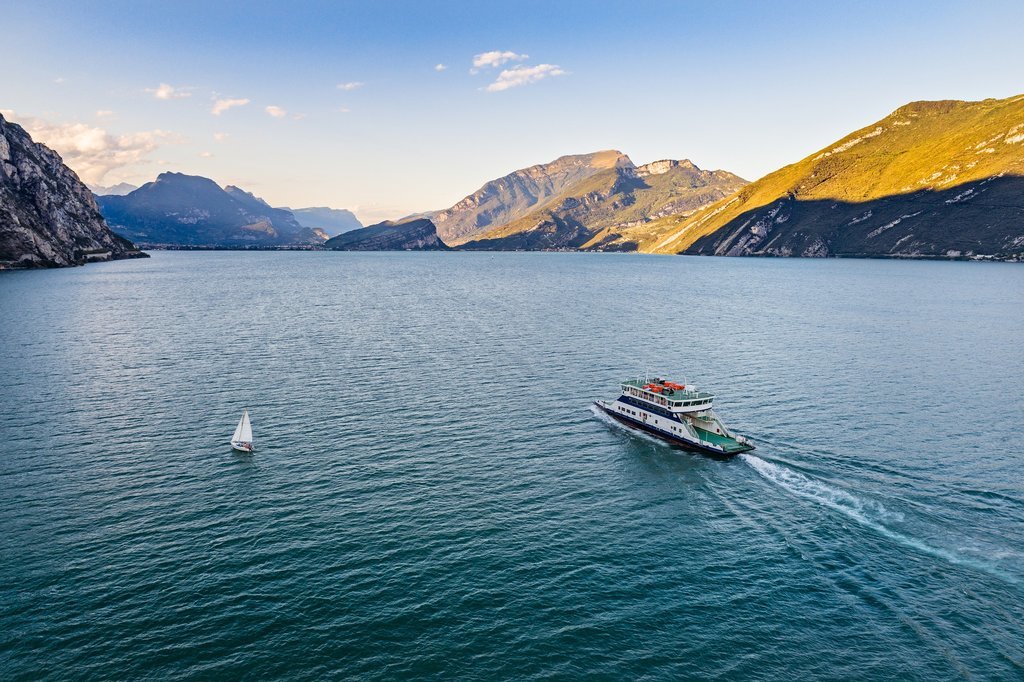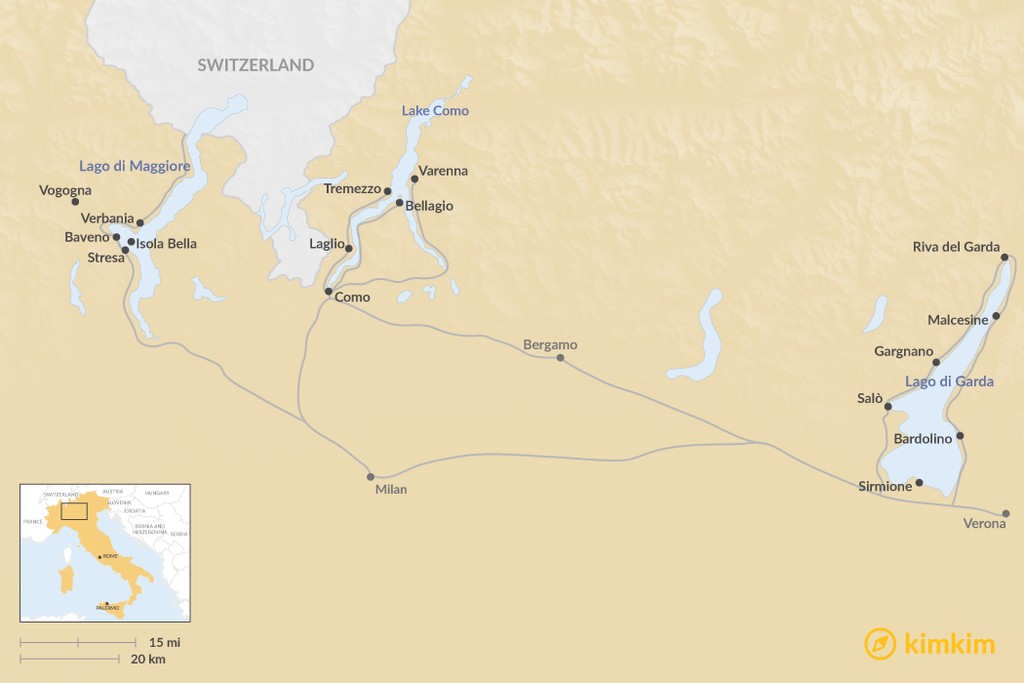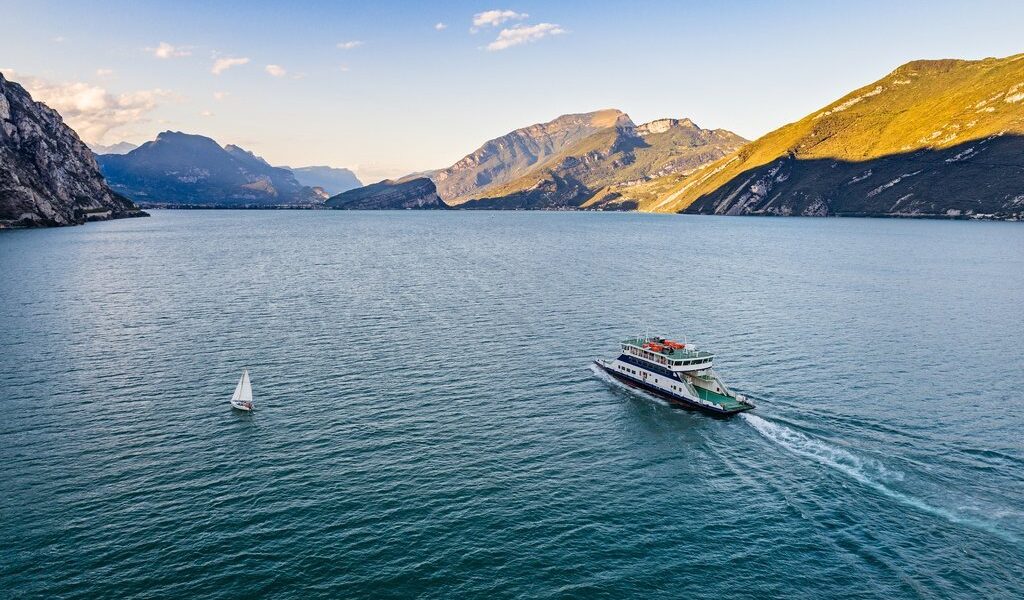
With mountain views, sapphire waters, pine-wooded slopes, and islands brimming with botanical gardens, the Italian Lakes are in many ways Italy at its dreamy best. Here lakefronts are lined with medieval towns and grand belle époque villas, beaches for swimming and sunbathing, and promenades made for aimless strolls. Visit the Italian Lakes, and you’ll happily master ‘il dolce far niente’: the art of doing nothing.
## Unveiling the Enchanting Allure of the Italian Lakes
Nestled gracefully in the embrace of the Alpine foothills and subtly bordering Switzerland, the Italian Lakes region is a mesmerizing tapestry of landscapes, colors, and experiences. This idyllic corner of Italy possesses a unique ability to capture and reflect every passing mood and fleeting moment, offering an unparalleled travel destination. Here, you are invited to immerse yourself in the splendor of the great outdoors, choosing to explore its wonders on foot, by boat, or perhaps even by bicycle. For those seeking breathtaking panoramas, a cable car ride to the majestic mountain heights promises unforgettable vistas. Alternatively, you might embark on a delightful journey, hopping between the region’s esteemed wineries, savoring the fruits of the land.
The culinary scene here is a delightful exploration of regional specialties, with menus brimming with delectable offerings. Indulge in the comforting warmth of *gnocchi* (those delightful potato or semolina dumplings) elevated by the rich flavors of hazelnuts and the distinct tang of gorgonzola cheese. Savor the complexity of risotto, infused with the deep, robust character of Barolo red wine, a true testament to Italian gastronomy. And, of course, delight in the abundance of fresh lake fish, with pike-perch and trout taking center stage on many a plate. But perhaps the most rewarding experience to be had in this remarkable place is to simply relax and wholeheartedly embrace *il dolce far niente*: the exquisite art of doing nothing, of finding joy in the simple pleasures of existence.
## Planning Your Excursion to the Italian Lakes
### Optimal Timing for Your Lakeside Escape
The Italian Lakes, sheltered by the towering mountains that define this northern Italian region, uniquely combine the most desirable aspects of both the Alpine and Mediterranean climates. During the cooler months, snow delicately dusts the mountain peaks, creating a picturesque contrast against the backdrop. Yet, simultaneously, the lakefront promenades are adorned with the vibrant colors and lush foliage of palm trees and exotic flowers, a testament to the region’s temperate allure.
During the peak of summer, the lakes become a magnet for travelers from around the globe, particularly in August when the Italian locals themselves embark on their own holidays, resulting in roads congested with traffic. For a more serene and enjoyable experience, consider visiting in the spring, when the shores and gardens erupt in a symphony of fragrant blooms. Early autumn, specifically September, offers another reliable window of opportunity, providing the added visual treat of fall colors painting the woodlands in warm hues.
From November through February, the resorts transition into a state of quiet tranquility, with visitor numbers dwindling to a mere trickle. Consequently, many boat services also experience a reduction in their schedules during this winter period, reflecting the slower pace of life.
The region boasts a wide array of accommodation options, but it’s crucial to remember that the most sought-after spots tend to fill up rapidly during the high summer season, particularly in August. Furthermore, many hotels choose to temporarily close their doors for the winter season, spanning from November through February.
### Navigating Your Way: Arrival and Exploration
Milan Malpensa Airport serves as the primary international gateway to the Italian Lakes region. Conveniently, it’s located approximately a 30-minute drive from the southern tip of Lago Maggiore, and roughly 45 minutes from Como, which graces the southern shore of its namesake lake. For those specifically targeting Lake Garda, Verona Airport offers a closer proximity.
To facilitate exploration of the lakes themselves, the Navigazione Laghi ferries offer a seamless and scenic mode of transportation, gliding across the water and connecting the various towns and resorts. Timetables and tickets can be readily accessed online, or purchased at the designated booths located in the harbors. Be sure to inquire about the money-saving ‘free circulation’ tickets, which provide coverage for multiple stops, maximizing your exploration opportunities.
## Lago Maggiore: A Realm of Historic Islands and Medieval Villages
### A Tapestry of Highlights and Activities
Gracefully straddling the regional divide between Lombardy and Piedmont, Lago Maggiore possesses a unique and captivating beauty. The lake is framed by majestic mountains, often snowcapped in winter, providing a stunning backdrop to the shores dotted with charming medieval, stone-built villages. As you explore, you’ll encounter elegant 19th-century villas, grand hotels exuding timeless charm, and meticulously curated botanical gardens. Historic towns also await, where life unfolds at a relaxed pace around picturesque piazzas.
**Stresa** serves as an excellent starting point for discovering the wonders of the lake. This town holds a special place in literary history, as it was here that Ernest Hemingway sojourned in 1918, recovering from a war injury. He was utterly captivated by the place, declaring, “This beats paradise to all hell,” while standing atop the 1491-meter summit of Mottarone, overlooking the town. A convenient cable car transports visitors from the lake shore to this summit in a mere 20 minutes, rewarding them with far-reaching views of the Italian and Swiss Alps, the surrounding lakes, and the vast expanse of the Po Plain.
From Stresa, a short ferry hop will transport you to the **Borromean Islands**, undoubtedly one of the lake’s most prominent highlights. A visit to **Isola Bella** is an easy and rewarding day trip, with the centerpiece being the magnificent Palazzo Borromeo. This 17th-century creation, the vision of Count Vitaliano, stands as a testament to artistic ambition, featuring a shell-encrusted grotto and meticulously terraced gardens to explore. Notably, Napoleon himself graced this palace with his presence in 1797. For those seeking a more secluded experience, the less-visited islands offer their own unique charm. **Isola dei Pescatori** (Fishermen’s Island) offers a low-key atmosphere, with simple restaurants serving freshly grilled lake fish, a true taste of local tradition. Meanwhile, **Isola Madre** boasts lush botanical gardens, teeming with rhododendrons, camellias, azaleas, and wisteria, creating a sensory explosion of color and fragrance.
On your tour of Lago Maggiore, be sure to include a visit to **Verbania**, home to the unmissable Villa Taranto gardens. These gardens are a symphony of fountains, sculptures, and rare botanical species, all conceived by the creative mind of Scottish Captain McEacharn, who designed them in 1931. Just north of Verbania, near the Swiss border, **Cannobio** offers a delightful experience, with its mazy historic center characterized by cobbled lanes that wind past pastel-painted houses. On the lakefront, an appealing lido beach beckons for swimming, lounging, and windsurfing. Venture north of Cannobio, and you’ll encounter hairpin bends that twist precariously into the wild, waterfall-laced mountains of the **Val Cannobina**, an ideal destination for hiking and mountain biking enthusiasts.
### Accommodations and Culinary Delights
For an affordable boutique option, consider **Hotel Palma** in Stresa, offering a panoramic pool and a sky bar with stunning views of the lake. For a taste of old-fashioned luxury, elevate your budget and spend a night at the opulent **Grand Hotel des Iles Borromées**, a chandelier-lit establishment that has been a fixture since 1863. In addition to its medical spa, the hotel boasts fabulous lake views and fountain-splashed gardens. Other notable choices include **Hotel Pironi** in Cannobio, a 15th-century palazzo stylishly revamped as a boutique hotel, and the intimate, wisteria-draped **Locanda di Orta** in Orta San Giulio, complete with a season-driven Michelin-starred restaurant.
To savor the catch of the day, fresh from the lake, explore the restaurants on Isola dei Pescatori, such as the lakefront **Trattoria Imbarcadero**. Other excellent options include **Osteria Mercato** in Stresa, known for its delicious home cooking with a regional slant – think creamy risotto with artichokes and polenta-stuffed ravioli.
## Lago di Como: A Spectacle of Showstopping Scenery and Lakeside Villas
### A Journey Through Highlights and Activities
It’s a challenging decision, but **Lago di Como** (Lake Como in English) could very well be the most dramatic and visually stunning of all the Italian Lakes, with the snow-dusted Rhaetian Alps towering majestically above its green-blue waters. The lake also possesses an undeniable allure, with its shores and steeply wooded hills dotted with lavish villas and immaculately maintained gardens.
The town of **Como** provides a charming base for exploration. You’ll want to stroll along the lakefront promenade, lined with grand mansions and villas, and explore the marble-clad Gothic cathedral, remarkable for its octagonal form. The walled medieval center features a diverse array of bars, restaurants, and cafes. On the outskirts of town, the Museo della Seta offers an insightful glimpse into Como’s distinguished history as one of the world’s largest silk producers. For panoramic views stretching out over the lakes and deep into the Swiss Alps, take a ride on the Como-Brunate funicular.
If you crave peace and tranquility, the smaller hamlets scattered around the lake offer a more appealing experience. **Bellagio**, situated at the tip of a promontory where the lake forks, offers breathtaking mountain views. This small village boasts a beautiful lido beach and the captivating gardens of Villa Serbelloni to explore.
The villas of the rich and famous draw visitors to **Cernobbio** and nearby **Laglio**, most notably Villa Oleandra, the summer residence of George and Amal Clooney. North of Cernobbio, near **Lenno**, is the romantically perched Villa del Balbianello, where scenes from the 2006 Casino Royale Bond movie were filmed.
Other stops worthy of inclusion on your itinerary are Villa Carlotta in **Tremezzo**, presented to a Prussian princess as a wedding gift in 1847. Its harmonious lakefront gardens burst with rhododendrons and azaleas in spring. Over on the lake’s eastern shore, the photogenic, brightly colored village of **Varenna** nestles at the foot of steep, wooded slopes. Here, the former Cistercian convent of **Villa Monastero** leads to expansive botanical gardens.
### Where to Reside and Dine
Nestled in lakefront gardens, the **Palace Hotel** in Como seamlessly blends old-world style with sensational views. Alternatively, consider the simple, central, and friendly **Albergo del Duca**. In Bellagio, indulge in the ultimate honeymoon experience at the romantic and ever-so-grand **Villa Serbelloni**, or enjoy five-star treatment at **Villa d’Este** in Cernobbio, a 16th-century palace set within terraced gardens.
Unforgettable meals are served with picturesque lake backdrops (ideal for sunset viewing) at establishments such as **La Vista** at Albergo Milano in Varenna, and **Trattoria Baita Belvedere**, perched high in the hills above Bellagio.
## Lago di Garda: A Playground for Outdoor Activities and Family Fun
### The Highlights and Exciting Activities Await
As the easternmost of the Italian Lakes, Lago di Garda graces the three regions of Lombardy, Veneto, and Trentino-Alto Adige. This lake offers a distinctly different ambiance than the others, catering more towards families drawn by outdoor activities and theme parks like Gardaland and CanevaWorld. Lago di Garda boasts phenomenal scenery, gently touching the foothills of the Dolomites in the north and framed by mountains wooded with pines, firs, olive, and lemon groves.
Poetic souls from verse-composing Romans to Tennyson, Lord Byron, DH Lawrence, and Ezra Pound have all found a fondness for **Sirmione** and its distinctly medieval profile that juts out on a southern peninsula. Rising above its collection of lanes and piazzas is a turreted 13th-century fortress. The ruins of Grotte di Catullo form one of the most important Roman sites in northern Italy. However, if you simply wish to escape the heat, you can head to the town’s pebble beach or thermal spa.
On the western shore of the lake lies the **Valtènesi**, a region renowned for its vineyards and olive groves. Here, clearly marked trails weave through holm oak woods, leading to tranquil beaches within the **Rocca di Manerba** nature reserve.
Other highlights to incorporate into your visit include the mountain-backed **Salò** and its lakefront promenade, **Gardone Riviera** with its opulent villas and exotic gardens, and **Riva del Garda** for its waterfalls and array of outdoor activities (mountain biking, canyoning, kitesurfing, windsurfing – you name it!). The castle-topped **Malcesine** is also charming, featuring a labyrinthine old center and a cable car whisking you up to 5774ft Monte Baldo for hiking, mountain biking, and paragliding adventures.
For wine enthusiasts, venture across to Bardolino on the southeastern shore to hop between cellars, enjoy tastings, and visit the Museo del Vino.
### Lodging and Dining Options
You’ll receive a warm reception at the family-run **Hotel Grifone** in Sirmione, which boasts views of the lake and castle. Surrounded by olive groves, **Hotel Olivi Thermae & Natural Spa** offers thermal baths, contemporary décor, and a convenient location near the lake. Other excellent choices include the lakefront **Hotel Vigna** in Salò and **Agriturismo Le Vai** in Bardolino, an upscale farm stay with a pool beautifully nestled among vineyards.
If you’re in search of a restaurant that emphasizes compelling lake views, try the smart **La Voglia** in Malcesine or the gourmet **La Speranzina** in the historic heart of Sirmione.

B-1413

